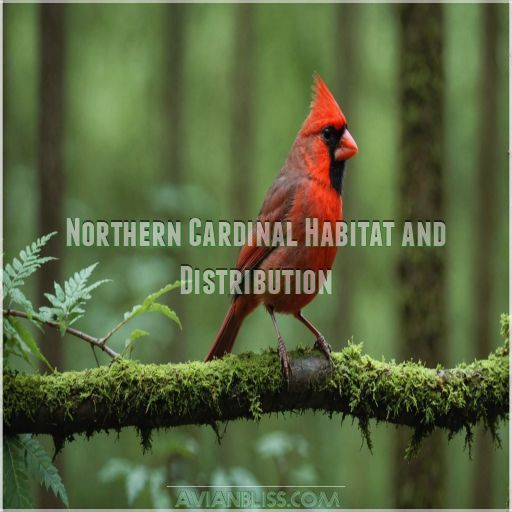This site is supported by our readers. We may earn a commission, at no cost to you, if you purchase through links.
 You’ll be glad to know that cardinals aren’t endangered.
You’ll be glad to know that cardinals aren’t endangered.
These vibrant red birds are actually thriving, with a stable population of about 130 million.
They’re classified as "Least Concern" by the IUCN, meaning they’re not at risk of extinction.
Cardinals have adapted well to suburban areas, often visiting backyard feeders.
However, they do face some threats like habitat loss and climate change.
While they’re not in danger now, it’s important to keep an eye on their population trends.
Cardinals play a key role in their ecosystems, helping with seed dispersal and insect control.
There’s more to learn about protecting these beloved backyard visitors.
Table Of Contents
- Key Takeaways
- Cardinal Endangerment Status
- Threats to Northern Cardinals
- Northern Cardinal Population Trends
- Conservation Efforts for Cardinals
- Northern Cardinal Protection Laws
- Why Are Northern Cardinals Important
- Northern Cardinal Habitat and Distribution
- Northern Cardinal Diet and Nutrition
- Northern Cardinal Behavior and Social Structure
- How to Help Protect Northern Cardinals
- Frequently Asked Questions (FAQs)
- Are northern cardinals endangered?
- Are Cardinals illegal?
- Are Cardinals facing extinction?
- Are yellow Cardinals endangered?
- Why are cardinals endangered?
- How rare is it to see cardinals?
- Are cardinals illegal to keep?
- Are cardinals federally protected?
- How do cardinals adapt to urban environments?
- What role do cardinals play in Native American cultures?
- Can cardinals interbreed with other bird species?
- How do cardinal vocalizations differ across subspecies?
- What impact do extreme weather events have on cardinals?
- Conclusion
Key Takeaways
- You’ll be relieved to know that Northern Cardinals aren’t endangered. Their population is stable at about 130 million, and they’re classified as "Least Concern" by the IUCN.
- While not endangered, cardinals face threats like habitat loss, climate change, and urban development. You can help by creating cardinal-friendly habitats in your yard and reducing human impacts.
- Cardinals play crucial ecological roles in seed dispersal and insect control. They’re also culturally significant, often seen as messengers from deceased loved ones in many traditions.
- You can’t keep cardinals as pets – they’re protected under the Migratory Bird Treaty Act. By understanding factors that affect their lifespan, such as learning how long cardinals live, you can create a welcoming environment for these birds. Instead, enjoy watching these vibrant birds in their natural habitats or at your backyard feeder.
Cardinal Endangerment Status
When you think about Northern Cardinals, you might wonder if they’re endangered.
Least Concern, meaning they’re not at immediate risk of extinction.
Despite facing threats, these vibrant birds are currently listed as "Least Concern".
Are Northern Cardinals Endangered?
Fortunately, the Northern Cardinal isn’t endangered – its population is stable and even increasing in some areas!
These vibrant red birds have adapted well to human-altered habitats like suburbs and parks.
While they face threats like predation and habitat loss, their resilience and adaptability keep their numbers strong.
Threats to Northern Cardinal Populations
While Northern Cardinals aren’t endangered, they face several challenges that could affect their populations.
You’ll find that threats include:
- Habitat loss due to urbanization.
- Climate change impacting migration patterns.
- Predator impact, such as domestic cats.
- Poaching concerns tied to illegal wildlife trade and demand for feathers.
Understanding these issues helps protect their survival.
Conservation Status of Northern Cardinals
You might wonder about the current conservation status of Northern Cardinals given the various threats they face.
Good news! They’re not endangered.
Northern Cardinals are classified as a species of Least Concern by the IUCN, thanks to their stable population.
These resilient birds thrive in changing environments, aided by protection laws like the U.S. Migratory Bird Act (Source).
What Does Least Concern Mean?
The Northern Cardinal’s positive conservation status marks it as "Least Concern."
But what does that really mean?
It means the species isn’t in dire straits with the IUCN classification.
Its population trends are stable, placing it at a low extinction risk in the species ranking.
Although it’s a bright feather in nature’s cap, continued monitoring helps guarantee a secure future outlook.

Threats to Northern Cardinals
When you think of Northern Cardinals, you might imagine their vibrant red color, but there’s more to know about their survival challenges.
They face threats like habitat loss, climate change, and predation, which impact their populations and require active conservation efforts.
Habitat Loss and Fragmentation
Urban sprawl impacts Northern cardinals by reducing their natural spaces.
Imagine losing your cozy bedroom—it’s like nesting site loss for these birds.
They face:
- Food source decline affecting survival.
- Population isolation due to fragmented habitats.
- Connectivity solutions needed for safe movement.
- Increased risks from predators and competition.
Addressing these concerns helps protect the beautiful cardinals.
Climate Change Effects
While urban sprawl chips away at cardinals’ habitats, climate change poses its own set of hurdles.
Shifts in temperature and unpredictable weather can alter migration patterns, disrupt food availability, and affect breeding success.
This causes resource scarcity as habitats alter.
Imagine the confusion of a cardinal packing its bags for an endless road trip, creating a challenge for their survival.
Predation and Human Impact
Cats and windows pose serious threats to Northern Cardinals.
Feline predators and window collisions can take a heavy toll on these vibrant birds.
Additionally, habitat loss from urbanization and pesticide use disrupt their populations.
But you can help – plant native plants, keep cats indoors, and install bird-friendly windows to support these backyard beauties.
Disease and Other Threats
Predators aren’t the only worry for Northern Cardinals.
They face threats from diseases like Salmonellosis and Avian Pox, often spread by human factors and habitat loss.
Parasites also plague these birds, weakening their defenses.
Keep an eye on your local cardinals, ensuring their habitats remain healthy and free from contaminants.
| Threat | Impact | Example |
|---|---|---|
| Disease | Avian health issues | Salmonellosis |
| Parasite impact | Feather damage | Mites, Lice |
| Climate threats | Habitat disruption | Extreme weather |
Northern Cardinal Population Trends
You might be surprised to learn that there are about 100 million Northern Cardinals flitting about.
Population decline could occur over time due to factors like habitat loss and climate change.
Estimated Global Population
Threats like habitat loss make people wonder about cardinal numbers.
Amazingly, Northern Cardinals boast a robust population.
Here’s a fascinating breakdown for you:
- Population Size: Approximately 130 million globally.
- Trends Over Time: Increasing by 0.32% annually since 1966.
- Regional Variations: Particularly abundant in eastern and central North America.
Declining Population Trends
Cardinals face challenges, yet they aren’t considered endangered.
Despite their vibrant presence, declining trends are notable due to habitat loss and urban sprawl.
Pesticide use and climate change also play roles in this shift.
Create bird-friendly environments to help cardinals thrive and avoid future scarcity.
| Factor | Impact on Cardinals |
|---|---|
| Habitat loss | Decreases nesting sites |
| Climate change | Alters food availability |
| Pesticide use | Reduces insect prey |
| Urban sprawl | Limits natural space |
Factors Affecting Population Decline
Imagine walking through a city park and noticing fewer Northern Cardinals.
Urban sprawl and habitat fragmentation reduce their nesting spaces.
Pesticide use harms their food sources, while climate change disrupts their environment.
Disease outbreaks further threaten their numbers.
It’s important to understand these factors to make sure these vibrant birds continue to brighten our neighborhoods for years to come.
Conservation Efforts for Cardinals
You can play a part in conserving cardinals by supporting protected areas and habitat restoration efforts.
Breeding programs and community education also help maintain their populations and guarantee these vibrant birds continue to thrive.
Protected Areas and Habitat Restoration
Nowadays, creating protected areas and restoring cardinal habitats are essential conservation efforts.
By planting native shrubs and trees, you can provide the shelter and nesting sites these birds need.
Urban wildlife corridors also help cardinals navigate safely through developed areas.
With your help, we can guarantee these vibrant songbirds thrive for generations to come.
Breeding Programs and Reintroduction
You may consider breeding programs very important for the long-term sustainability of cardinals.
Captive breeding success guarantees healthy populations, focusing on genetic diversity.
Reintroduction strategies aim to boost numbers in the wild, supported by population monitoring to track progress.
Together, these efforts help create a brighter future for these vibrant birds, making sure they remain a beloved part of our world.
Education and Community Involvement
Breeding programs help cardinals thrive, and your local community can play a part too.
Take advantage of citizen science projects or create a backyard habitat.
Join school programs or birdwatching clubs to foster learning and enjoyment.
Conservation outreach can be another step you take, spreading awareness and ensuring these beautiful birds continue to brighten our world.
Collaboration With Governments and Organizations
Conservation efforts for cardinals thrive on strong government partnerships, with organizations also focusing on addressing key threats such as window strike prevention.
These collaborations boost successful conservation strategies by focusing on a few key areas:
- Habitat protection to preserve natural environments
- Funding research for understanding cardinal populations better
- Public outreach for raising awareness
Such partnerships create a balanced approach to conserving these beautiful birds and their habitats.
Northern Cardinal Protection Laws
You might be surprised to learn that Northern Cardinals are protected by laws like the Migratory Bird Treaty Act.
Possessing one without a special license could cost you a hefty fine or even jail time, so it’s best to admire these red beauties from a distance.
Migratory Bird Treaty Act
Migratory Bird Treaty Act safeguards Northern Cardinals by prohibiting their capture or harm without a permit.
It covers a century of protection.
Rooted in treaties with Canada, Mexico, Japan, and Russia, it faces enforcement challenges but offers key international protection.
Understanding its conservation impact today helps guarantee these vibrant birds continue thriving tomorrow.
Federal and State Laws
Northern cardinals are protected under the Migratory Bird Treaty Act, which provides strict legal protections.
This act prevents you from harming these birds by making it illegal to kill, capture, or sell them without proper authorization.
The Northern Cardinal is also a symbol of state pride, being the state bird of seven US states, including Illinois, Indiana, and Kentucky, among others, which may influence local conservation efforts state bird symbolism.
State regulations may strengthen these protections to make sure compliance.
So, as you admire cardinals, remember they’re safeguarded by robust wildlife enforcement .
Licenses and Permits for Aviary Keepers
As an aviary keeper, you’ll need the right license to protect our feathered friends.
Obtain a biodiversity conservation license from the Department of Climate Change, Energy, the Environment and Water to legally keep native birds like the Northern Cardinal.
This helps you:
- Safeguard vulnerable species
- Abide by local laws
- Provide proper care
Penalties for Violations
Did you know ill-treatment of Northern Cardinals leads to penalties?
Fines loom large for conservation offenses under the Migratory Bird Treaty Act.
If you engage in illegal trade or harm these birds, expect hefty fines, potential jail time, or even license revocation.
It’s important to respect these laws to help cardinals thrive and avoid serious consequences.

Why Are Northern Cardinals Important
Northern Cardinals play a key role in maintaining a healthy ecosystem by spreading seeds and controlling insect populations.
Northern Cardinals also hold cultural significance, symbolizing beauty and vitality in various traditions.
Ecological Role in Seed Dispersal
Cardinals aren’t just beautiful, they’re fantastic garden helpers too.
With their diet including seeds and fruits, these birds play a big role in seed dispersal benefits, spreading seeds far and wide.
This helps boost plant diversity and shapes seed distribution patterns.
Their impact on the ecosystem is profound, making them critical to the health of many habitats.
Insect Population Control
Seeing red? That’s your Northern Cardinal helping with insect population control. They play a big role in keeping ecosystems balanced with their bug-eating habits. You might say they’re tiny natural pest control agents!
- Feast on various insects, reducing pest numbers.
- Support ecosystem balance by controlling insect populations.
- Contribute to Integrated Pest Management (IPM) strategies.
- Aid in limiting harmful pests without chemicals.
Cultural Significance and Symbolism
You might find cardinals fascinating for their symbolism in many cultures, often seen as messengers from deceased loved ones, offering comfort and reassurance, particularly when associated with what does it mean when you see a cardinal.
Known for their symbolism in many cultures. Known for their symbolism in many cultures. Known for their symbolism in many cultures. Known for their symbolism in many cultures. Known for their symbolism in many cultures. Known for their symbolism in many cultures. Known for their symbolism in many cultures. Known for their symbolism in many cultures. Known for their symbolism in many cultures. Known for their symbolism in many cultures. Known for their symbolism in many cultures. Known for their symbolism in many cultures. Known for their symbolism in many cultures. Known for their symbolism in many cultures. Known for their symbolism in many cultures. Known for their symbolism in many cultures. Known for their symbolism in many cultures. Known for their symbolism in many cultures. Known for their symbolism in many cultures. Known for their symbolism in many cultures. Known for their symbolism in many cultures. Known for their symbolism in many cultures. Known for their symbolism in many cultures. Known for their symbolism in many cultures. Known for their symbolism in many cultures. Known for their symbolism in many cultures. Known for their symbolism in many cultures. Known for their symbolism in many cultures. Known for their symbolism in many cultures. Known for their symbolism in many cultures. Known for their symbolism in many cultures. Known for their symbolism in many cultures Known for their symbolism in many cultures. Known for their symbolism in many cultures. Known for their symbolism in many cultures. Known for their symbolism in many cultures. Known for their symbolism in many cultures. Known for their symbolism in many cultures. Known for their symbolism in many cultures. Known for their symbolism in many cultures. Known for their symbolism in many cultures. Known for their symbolism in many cultures. Known for their symbolism in many cultures. Known for their symbolism in many cultures. Known for their symbolism in many cultures. Known for their symbolism in many cultures. Known for their symbolism in many cultures. Known for their symbolism in many cultures. Known for their symbolism in many cultures. Known for their symbolism in many cultures. Known for their symbolism in many cultures. Known for their symbolism in many cultures. Known for their symbolism in many cultures. Known for their
Northern Cardinal Habitat and Distribution
You’ll find Northern Cardinals across a wide range that includes the eastern and central United States, southeastern Canada, and parts of Mexico.
Although they face challenges like suburban development and climate change, these population changes have encouraged their expansion into areas like southern California and Hawai’i.
Geographic Range and Habitat
The vast geographic range of the Northern Cardinal spans from southern Canada to parts of Mexico and Central America.
This adaptable species thrives in a variety of habitats, including:
- Woodland edges and hedgerows
- Suburban and urban areas with bird feeders
- Riparian zones along rivers and streams
- Agricultural landscapes with dense vegetation
- Tropical regions in Mexico and Central America
Suburban Development and Urbanization
Northern Cardinals have adapted well to suburban development and urbanization.
These changes have increased nesting habitats and enabled them to winter in previously unsuitable areas.
Urban cardinals show less aggression and are more open to novelty than their rural counterparts.
However, habitat fragmentation, noise pollution, and light pollution pose challenges.
One effective way to attract cardinals is by using the best cardinal bird feeders, such as tube feeders with large perches, which provide ample space for these birds to feed comfortably. Bird feeders have positively impacted cardinal populations, helping them thrive in urban environments.
Their urban adaptation showcases nature’s resilience in the face of human-driven landscape changes.
Expansion of Range Due to Climate Change
Northern Cardinals, with a population of around 110 million individuals, are a species of low conservation concern, as stated in their Northern Cardinal species profile. Climate change’s impact on Northern Cardinals’ range is becoming increasingly apparent.
As temperatures shift, these adaptable birds are expanding their territories northward.
Here’s how climate change affects their distribution:
- Warmer winters allow cardinals to survive in previously inhospitable areas
- Urban heat islands create suitable microclimates in cities
- Changes in vegetation patterns provide new nesting opportunities
This expansion isn’t without challenges.
Cardinals must adapt to new food sources and compete with resident species.
Despite these hurdles, their resilience in the face of habitat shifts is remarkable.
Northern Cardinal Diet and Nutrition
Northern Cardinals have a varied diet that includes seeds, fruits, and insects.
Fruits provide important nutrients and insects offer essential protein for nestlings.
Their conical bill is well-suited for cracking seeds.
Granivorous Diet and Seed Preferences
You’ve seen cardinals in your backyard, but did you know they’re seed specialists?
These bright red beauties are granivores, equipped with stout, cone-shaped beaks perfect for cracking open seeds.
Their favorite menu items include sunflower seeds, safflower, and seed cylinders.
This seed-heavy diet, making up to 90% of their food intake, helps cardinals thrive year-round in various habitats.
They’re nature’s little seed-crackers, always ready for a seedy snack!
Importance of Fruits and Insects
While seeds are a staple, fruits and insects play a key role in cardinal diets.
Fruits provide essential nutrients and help disperse seeds.
Insects are highly important for nestling nutrition, making up almost their entire diet.
The vibrant red coloration of male cardinals, which comes from their diet of berries, seeds, and fruits, particularly influences their mating and social behaviors. The carotenoids in fruits contribute to the cardinal’s vibrant red plumage.
Cardinals also eat elm fruits, showcasing their adaptability.
This varied diet helps cardinals thrive in diverse habitats.
Dietary Flexibility and Adaptation
Northern cardinals are masters of adaptation in terms of their diet.
They change their food sources with the seasons, ensuring their survival year-round.
This adaptability helps them meet their high glucose requirements, as they need to consume up to 25% of their body weight in glucose to endure the winter, which they obtain from sources like berries and seeds.
Here’s how they adjust:
- Spring: Feast on insects and buds
- Summer: Enjoy a mix of insects and berries
- Fall: Bulk up on seeds and fruits
- Winter: Rely heavily on seeds and natural sources
This flexibility helps cardinals thrive in various environments, from forests to your backyard.

Northern Cardinal Behavior and Social Structure
Northern Cardinals have complex social lives, forming strong pair bonds and fiercely defending their territories.
They often engage in aggressive displays during breeding season.
They also participate in group activities like flocking outside of nesting periods.
Monogamous Relationships and Territorial Behavior
Cardinals are the lovebirds of the avian world, sticking together through thick and thin.
These red-feathered romantics form lasting bonds, often staying with their mate year-round.
Let’s take a peek at their relationship dynamics:
| Behavior | Purpose | Season |
|---|---|---|
| Song-dance display | Courtship | Spring |
| Territorial singing | Defense | Year-round |
| Courtship feeding | Pair bonding | Breeding |
Their dedication to family life is truly heartwarming, with both parents pitching in to raise their young.
Aggressive Behavior and Communication
You’ve seen their devotion, now let’s talk about their feisty side.
Cardinals aren’t just lovebirds; they’re fierce defenders too.
During breeding season, you’ll witness their territorial displays.
Males puff up their feathers and sing loudly to ward off intruders.
They’ll even attack their own reflections in windows, thinking it’s a rival.
Their aggressive behavior isn’t just for show – it’s a key part of protecting their nests and mates.
Social Interactions and Flocking
Despite their reputation for aggression, cardinal social structure isn’t all about territorial disputes.
They can often be seen foraging for seeds like sunflower seeds and safflower at backyard feeders learn more about common birds in ohio.
Outside breeding season, these birds can be quite sociable.
You’ll often spot them in small flocks, foraging together and sharing resources.
This flocking behavior helps them stay safe from predators and find food more easily.
During winter, cardinals may even join mixed-species flocks, showing their adaptable nature.
How to Help Protect Northern Cardinals
You can help protect Northern Cardinals by creating bird-friendly spaces in your yard and reducing threats in your area.
Your actions can make a difference in supporting these vibrant birds and their habitats.
Creating Cardinal-Friendly Habitats
Now that we’ve explored cardinal behavior, let’s roll up our sleeves and create a backyard oasis.
Plant native shrubs and trees for nesting spots.
Set up bird feeders at different heights to mimic natural feeding zones.
Don’t forget a shallow birdbath for drinking and bathing.
Your yard will become a cardinal hotspot, and you’ll enjoy watching these beautiful birds thrive in their new home.
Reducing Threats and Human Impact
While creating a cardinal-friendly habitat is great, it’s equally important to reduce threats.
Keep cats indoors to prevent predation.
Install window decals or screens to minimize collisions.
Limit pesticide use in your yard to protect cardinals and their food sources.
Combat urban sprawl by supporting local habitat restoration projects.
These simple steps can make a big difference in protecting our red-feathered friends and their ecosystem.
Supporting Conservation Efforts and Organizations
You can make a real difference for Northern Cardinals.
Join birdwatching groups to contribute to citizen science projects, tracking cardinal populations.
Donate to organizations like ABC that protect birds and their habitats.
Volunteer for local conservation efforts or habitat restoration projects.
Use your voice for advocacy, supporting wildlife-friendly policies.
Every action, big or small, helps these beloved red birds thrive in our shared environment.
Frequently Asked Questions (FAQs)
Are northern cardinals endangered?
Picture a vibrant red bird perched on your backyard feeder, which is likely a cardinal, known for its bold red plumage, often found in dense vegetation, or perhaps you have a red robin vs cardinal visiting your yard.
That’s a northern cardinal, and you’ll be glad to know they’re not endangered.
Their population is stable, with about 130 million worldwide.
They’re protected by law.
Are Cardinals illegal?
Cardinals aren’t illegal to observe, but keeping them as pets is.
They’re protected under federal law.
It’s against regulations to possess their feathers, skulls, or any part.
Admire these beautiful birds in their natural habitat instead.
Are Cardinals facing extinction?
Our feathered friends aren’t in hot water just yet.
While some bird species face challenges, cardinals aren’t currently at risk of vanishing.
They’re adaptable and widespread across North America, so you can keep enjoying their vibrant presence.
Are yellow Cardinals endangered?
Yellow cardinals are incredibly rare, with only about 12 out of 12 million North American cardinals being yellow.
They’re not officially endangered, but their scarcity makes them special.
You’ve got a one-in-a-million chance of spotting one!
Why are cardinals endangered?
Surprisingly, these vibrant birds aren’t endangered.
You’ll find cardinals thriving in human-altered habitats.
They face common threats like cats, pesticides, and window collisions.
Conservation efforts protect them, but you can help by creating bird-friendly spaces in your yard.
How rare is it to see cardinals?
Cardinals aren’t rare at all.
You’ll often spot these vibrant birds in backyards, parks, and forests across North America.
They’re year-round residents, so you’ve got a good chance of seeing their striking red plumage any time.
Are cardinals illegal to keep?
Like a caged songbird, keeping cardinals as pets is illegal in the US.
The Migratory Bird Treaty Act protects these vibrant birds.
You’ll have to admire their beauty in nature, where they belong.
Enjoy their visits to your backyard instead.
Are cardinals federally protected?
Yes, cardinals are federally protected under the Migratory Bird Treaty Act.
You can’t kill, capture, or possess them without a permit.
This protection covers all parts of the bird, including feathers, eggs, and nests.
How do cardinals adapt to urban environments?
You’ll find these bright birds thriving in cities.
They adapt by eating invasive honeysuckle berries, nesting in urban greenery, and adjusting their songs to higher frequencies.
Their eyes may even shrink to cope with city lights.
What role do cardinals play in Native American cultures?
As messengers from above, cardinals play a key role in Native American cultures.
They’re seen as harbingers of good fortune, with some tribes believing a cardinal sighting brings luck within 12 days.
They symbolize devotion, love, and monogamy. (Source)
Can cardinals interbreed with other bird species?
Cardinals typically don’t interbreed with other bird species.
They’re territorial and form monogamous pairs.
However, in winter, they flock with different species like Dark-eyed Juncos and White-throated Sparrows, showing a more social side to their nature.
How do cardinal vocalizations differ across subspecies?
Cardinal vocalizations vary considerably across subspecies.
You’ll hear distinct song types and dialects in different regions.
Sonoran and Chihuahuan cardinals, for instance, have songs as different as Portuguese and German.
These differences play a role in mate selection and territorial defense.
What impact do extreme weather events have on cardinals?
Like a boxer facing a heavyweight, cardinals weather extreme events with resilience.
They’ll adapt to temperature shifts, seeking shelter during storms.
They’ll eat more before bad weather hits, fueling up to survive nature’s challenges (Source).
Conclusion
Picture cardinals as resilient survivors in nature’s grand tapestry.
While not endangered, these vibrant birds still face challenges.
Are cardinals endangered? No, but their future isn’t guaranteed.
By creating bird-friendly spaces, reducing threats, and supporting conservation efforts, you can help make sure cardinals continue to brighten our world.
Remember, every small action counts.
As you admire their brilliant plumage and cheerful songs, know that you’re part of the solution in keeping these beloved birds thriving for generations to come.













